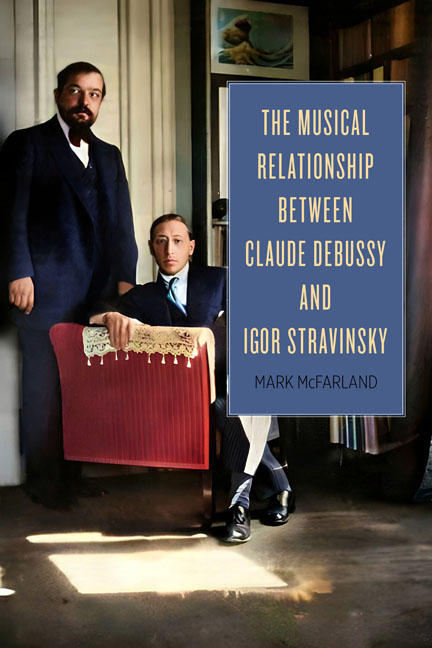Book contents
- Frontmatter
- Dedication
- Contents
- Acknowledgments
- Introduction
- 1 A Mutual Influence
- 2 Cinematic Montage and Stratified Form
- 3 Stratified Form in Debussy’s Works: 1909–1913
- 4 Debussy and the Chromatic Set
- 5 Stratified Form in Jeux
- 6 Stravinsky’s Waning Influence: 1914–1917
- Conclusion
- Glossary
- Bibliography
- Index
2 - Cinematic Montage and Stratified Form
Published online by Cambridge University Press: 10 May 2024
- Frontmatter
- Dedication
- Contents
- Acknowledgments
- Introduction
- 1 A Mutual Influence
- 2 Cinematic Montage and Stratified Form
- 3 Stratified Form in Debussy’s Works: 1909–1913
- 4 Debussy and the Chromatic Set
- 5 Stratified Form in Jeux
- 6 Stravinsky’s Waning Influence: 1914–1917
- Conclusion
- Glossary
- Bibliography
- Index
Summary
Debussy and Stravinsky met in 1910, shortly after a revolution had begun just before the turn of the century in the field of cinema. In fact, so radical was this revolution, and so compatible were early cinema and contemporary music, that certain film techniques quite likely influenced both these composers.
Cinematic Montage
In the history of the early cinema, filmmakers who had experience in both photography and theater were able to quickly explore the technical possibilities now available to them. These included the traveling shot, used exclusively in a Lumière film of 1896 showing a gondola sailing down the Grand Canal in Venice; extreme close-ups, used in the George Albert Smith film Grandma's Reading Glass from 1900; film reversal (so simple an effect that films of all sorts were often shown forward and then again backward for comic effect); enlarging or reducing an image, used in George Méliès's film L’homme à la tête de caoutchouc (The Man with the Rubber Head) of 1901, in which a man's rubber head is inflated until it explodes; and substitution (stopping the camera and changing the scene before restarting it), found in Alfred Clark's The Execution of Mary Stuart from 1895, which contains a convincing depiction of a beheading. As advanced as these camera techniques were, these early films—unsophisticated efforts that were certainly not considered works of art—could not have been expected to influence contemporary musicians. This is because, as film historian David Robinson notes, “by 1900, the film's visual vocabulary had been recognized. Only gradually was the idea of a syntax appreciated, the notion that the essence of cinema is the juxtaposition of shots into an expressive continuity.”
While advances were being made in camera techniques, film continuity was maintained in the simplest way possible, through a single shot of a single scene. Edwin Porter's 1902 film The Life of an American Fireman represented the first step toward the modern conception of cinematic montage. Porter exploited imagery of fire—one of the most popular subjects of early cinema—and built a film around various scenes of fires and firemen while adding some additional material of his own. From this, he constructed a dramatic film that is little-known today but widely discussed in film history, as it was the first to show that “the meaning of a shot was not self-contained but could be modified by joining the shot to others.”
- Type
- Chapter
- Information
- Publisher: Boydell & BrewerPrint publication year: 2024



